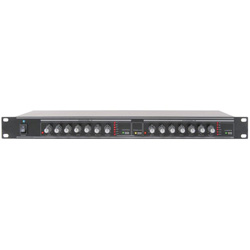Limiters are in the protection business, limiting audio systems to safe levels.
These limits protect loudspeakers, protect the audio signal from clipping, protect the neighbors, and protect ears.
A limiter continuously monitors the audio signal, looking for levels exceeding its adjustable threshold. A limiter normally operates at unity gain and has no effect on the signal.
If excessive levels are detected, the Voltage Controlled Attenuator (VCA) automatically reduces the gain. If the level never exceeds the threshold, the signal remains unaffected.
Auto-Slave, Extending Your Limits
In the applications and examples that follow, you will read about multi-channel limiters with auto-slave. Auto-slaving provides the ability to tie together the circuitry that controls the VCA’s of two or more limiters.
Each limiter channel maintains its independent threshold adjustment. The amount of gain reduction is shared with all slaved channels when any one has exceeded its threshold.
Protecting Loudspeakers with Limiters
Loudspeakers manufacturers provide recommended power ratings for their drivers. These ratings are not absolute, and should be used only as a guide.
Sound contractors diverse experiences using loudspeakers sometimes lead them to formulate their own power ratings. Limiters allow for real world applications. With a limiter you can customize your speaker protection scheme for maximum reliability.
It is important to note that midrange and tweeter (high-frequency) drivers cannot handle as much power as woofers (low-frequency drivers). Therefore it is especially important that tweeters and midranges are protected by different limiter thresholds than the woofer.
Multi-amped systems often use limiters for speaker protection. Limiters are typically placed at the input of each power amplifier for each driver.
Whenever the high, mid or low limiters reach their set limit threshold, all three bands limit by the same amount.
This is due to the three slaved channels in the limiter, assuring the system’s spectral balance stays constant.
If only one band limited and the other two increased in volume, the result would be an abrupt change in the tonal balance of the system.
This clever trick provides the least audible and most effective form of multi-amped system power limiting.
Taking Your System to the Limit
A properly designed system has the ability to operate as loudly as needed for the application. When limiters are introduced into a system their thresholds are set to protect the systems’ components.
Sometimes limiting occurs before a satisfactory volume level is reached. For example, a touring band could perform in a venue that is much bigger than its equipment can handle.
Higher power speakers or more powerful amplifiers may be called for. This permits higher limit levels to be set, thus allowing a louder system.















